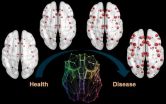The study shows that obesity leads to subclinical heart muscle injury and increases the risk for heart failure even among people without overt heart disease and independently of other cardiovascular risk factors such as diabetes, high blood pressure and high cholesterol. The silent heart damage was detected by using an ultrasensitive test that measures the levels of a protein released by the cells of the heart muscle during injury. The findings suggest that obesity is an independent driver of heart muscle damage, and that obese individuals, even when free of cardiac symptoms, warrant vigilant monitoring.
Using an ultrasensitive blood test to detect the presence of a protein that heralds heart muscle injury, researchers from Johns Hopkins and elsewhere have found that obese people without overt heart disease experience silent cardiac damage that fuels their risk for heart failure down the road.
The findings of the federally funded study, published ahead of print in the Journal of the American College of Cardiology: Heart Failure, challenge the commonly held belief that much of the cardiovascular disease seen in severely overweight people is driven by diabetes and high blood pressure, both well-known cardiac risk factors and both occurring frequently among the obese.
Specifically, the research showed that obese people had elevated levels of a heart enzyme known as troponin T, released by injured heart muscle cells. Increases in levels of this enzyme corresponded to increases in people's body mass index (BMI) -- a measure of body fat based on a person's weight-to-height ratio. Levels of the enzyme rose proportionally as BMI went up.
Troponin T is the gold standard for diagnosing acute or recent heart attacks and is widely used in emergency rooms to test patients with chest pain and other symptoms suggestive of a heart attack. The test used in the current study works in much the same way, but is calibrated to detect troponin levels far below the ranges of the clinical test for diagnosing a heart attack.
"Obesity is a well-known 'accomplice' in the development of heart disease, but our findings suggest it may be a solo player that drives heart failure independently of other risk factors that are often found among those with excess weight," says lead investigator Chiadi Ndumele, M.D., M.H.S., an assistant professor at the Johns Hopkins Ciccarone Center for the Prevention of Heart Disease. "The direct relationship we found between obesity and subclinical heart damage is quite potent and truly concerning from a public health standpoint given the growing number of obese people in the United States and worldwide."
For the study, investigators measured the BMIs and cardiac troponin levels of more than 9,500 heart disease-free men and women, aged 53 to 75, living in Maryland, Mississippi, North Carolina and Minnesota. The researchers then tracked the participants' health for more than 12 years. During the follow-up, 869 people developed heart failure.
People who were severely obese -- those with a BMI above 35 -- had more than twice the risk of developing heart failure, compared with people of normal weight, the researchers found. That risk rose incrementally with BMI, growing by 32 percent for every five-unit increase in BMI. Thus, a 6-foot, 225-pound man with a BMI of 30 was 32 percent more likely to develop heart failure than a 6-foot, 188-pound man with a BMI of 25. All people with elevated troponin levels, regardless of BMI, had higher risk of developing heart failure over a decade. In other words, extra weight and high troponin each independently signaled higher heart disease risk.
When the researchers calculated the combined effects of elevated troponin and severe obesity, the predictive power was striking. Severely obese people with elevated troponin levels were nine times more likely to develop heart failure than people with normal weight and undetectable troponin levels. The elevated risk persisted even when investigators accounted for other possible causes of heart damage, including diabetes, hypertension and high cholesterol.
Public health experts deem heart failure -- a condition in which the heart muscle doesn't pump efficiently -- a looming epidemic. The disease has been on a steady rise and is expected to affect one in five adults by 2030.
Ndumele and team say the findings underscore the dangers of obesity and should be heeded as an alarm bell for clinicians to monitor their obese patients rigorously for emerging sings heart disease.
"These results are a wake-up call that obesity may further fuel the growing rate of heart failure, and clinicians who care for obese people should not be lulled into a false sense of security by the absence of traditional risk factors, such as high cholesterol, diabetes and hypertension," says Roger Blumenthal, M.D., director of the Johns Hopkins Ciccarone Center for the Prevention of Heart Disease. "Obese people, even when free of cardiovascular symptoms, should be monitored for the earliest signs of heart failure and counseled on ways to improve their lifestyle habits."
The investigators say their next step is to study the precise mechanism by which obesity causes subclinical heart muscle damage, and whether reduction in weight would lower the risk for heart failure.
INFORMATION:
The research was funded by the National Heart, Lung and Blood Institute.
Other Johns Hopkins investigators involved in the study included Josef Coresh, Mariana Lazo and Elizabeth Selvin. Other institutions involved in the study included Baylor College of Medicine, the University of Minnesota, the Michael E. DeBakey VA Medical Center in Houston and the Houston Methodist DeBakey Heart & Vascular Center.
Johns Hopkins Medicine (JHM), headquartered in Baltimore, Maryland, is a $7 billion integrated global health enterprise and one of the leading academic health care systems in the United States. JHM unites physicians and scientists of the Johns Hopkins University School of Medicine with the organizations, health professionals and facilities of The Johns Hopkins Hospital and Health System. JHM's vision, "Together, we will deliver the promise of medicine," is supported by its mission to improve the health of the community and the world by setting the standard of excellence in medical education, research and clinical care. Diverse and inclusive, JHM educates medical students, scientists, health care professionals and the public; conducts biomedical research; and provides patient-centered medicine to prevent, diagnose and treat human illness. JHM operates six academic and community hospitals, four suburban health care and surgery centers, and more than 39 Johns Hopkins Community Physicians sites. The Johns Hopkins Hospital, opened in 1889, has been ranked number one in the nation by U.S. News & World Report for 22 years of the survey's 25 year history, most recently in 2013. For more information about Johns Hopkins Medicine, its research, education and clinical programs, and for the latest health, science and research news, visit http://www.hopkinsmedicine.org
Media contacts:
Ekaterina Pesheva, epeshev1@jhmi.edu (410) 502-9433
Helen Jones, hjones49@jhmi.edu (410) 502-9422 END





